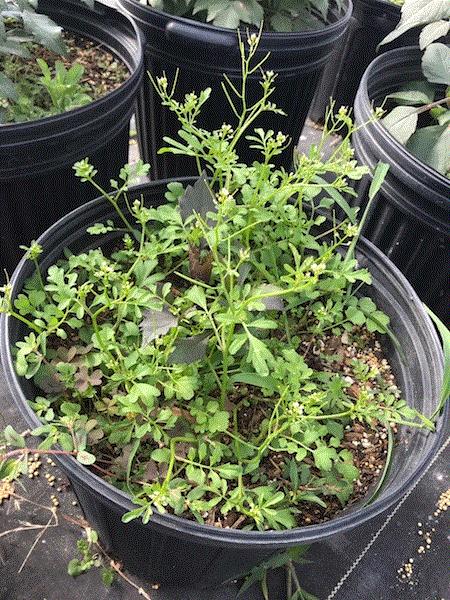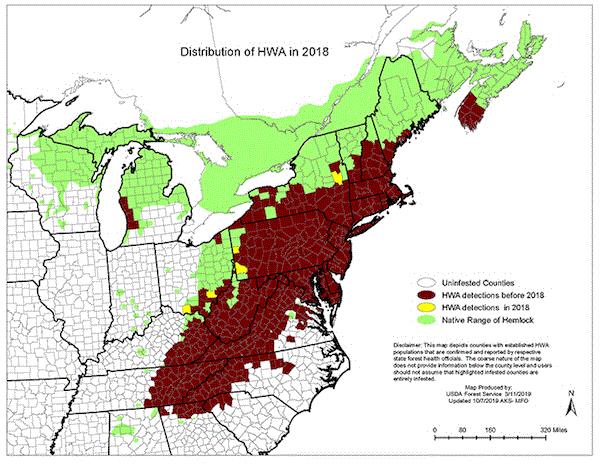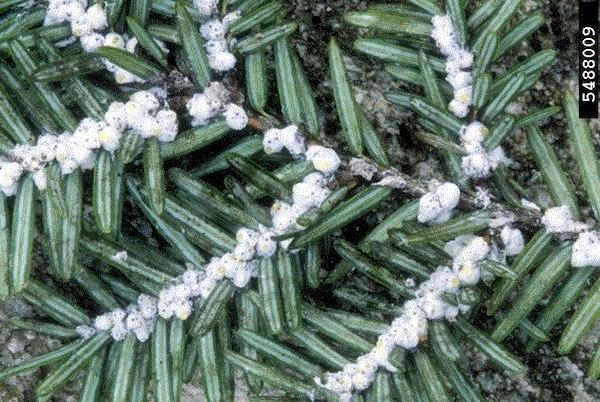Spider mites gone wild
One of the hottest topics in our gossip group is who among our friends has gone insane during this time of pandemic and social distancing. I’ve basically been locked out of my office and lab for more than a month now. I think more and more people are betting on me as the next one to crack.
I know those plants in my research greenhouses are suffering without my “TLC.” Actually, if they could talk, they’d probably beg me not to put weird bugs on them. Some of them did get bugs without me even trying.
I have a group of roses that I’ve been growing for a year in preparation for an American Floral Endowment-funded study on controlling thrips. The study is delayed since my graduate student and workers can’t get to them right now. I see these roses once a week when it’s my turn to water them. I found them completely covered with spider mites this weekend! They were fine last weekend. That just tells you how quickly spider mites can get out of hand when you take your eyes off the plants.

If y’all are holding plants during this pandemic, you better watch out for tiny little bugs that can make you wish you had killed those suffering plants yourself from the beginning.
So, what am I going to do? I normally suggest using predatory mites to keep the population in check. But I clearly let the spider mites go to town for too long, so I'd better bring up one of the miticides in my chemical storage. That, hopefully, will knock down the population, and I’ll follow with biological control.
I’ve tested quite a few miticides in past few years. Avid (abamectin; IRAC 6), Floramite (bifenazate; 20D), Pylon (chlorfenapyr; 13), Savate (spiromesifen; 23), Shuttle (acequinocyl; 20B), Sirocco (abamectin + bifenazate; 6 + 20D) and Sultan (cyflumetofen; 25) all worked very well. These are only the ones I’d tested. Many more miticides are available. If I’m using predatory mites, I will stay away from Pylon, Avid and Sirocco. I’ll also wait at least a week after the application before releasing more predatory mites to minimize the impact of miticide residue on the predatory mites. Also, remember: rotation of miticides is a must!

Bittercress, anyone?
If you are looking for bittercress to add to your collection, I have thousands of seeds saved up for ya! I can ship them tomorrow. Email me by clicking here.
After seeing my wealth of spider mites, I was also shocked by how much the bittercress has taken over my pots of dahlias. Although this is the time when bittercress is supposed to be the most numerous, since it is a cool-season weed in my part of the country, the visual effect was still quite strong. I didn't spend time identifying it, but the rounded leaves of the seedlings look like a hairy bittercress. So, I’m just going to call it hairy bittercress.

Again, this bittercress is one of the things that had gotten out of hand when I wasn’t looking. My punishment was to spend the entire Sunday morning hand-pulling them. Also, I pulled out oxalis and a bunch of other stuff at the same time. Looks good for another two weeks. It’s great to be working with my hands again.
One key to successfully controlling bittercress is not to let them go to seed. The seeds are small and numerous, and the seedlings can grow thick. The best management approach is to apply a pre-emergence herbicide. Joe Neal of North Carolina State University listed Broadstar (flumioxazin; WSSA 14), Gallery (isoxaben; 21), OH2 (oxyfluorfen + pendimethalin; 14 + 3), Regal O-O (oxyfluorfen + oxadiazon; both 14), Ronstar (oxadiazon; 14), Rout (oxyfluorfen + oryzalin; 14 + 3), Showcase (trifluralin + isoxaben + oxyfluorfen; 3 + 21 + 14) and Snapshot (trifluralin + isoxaben; 3 + 21) as having good efficacy against bittercress in his Weeds of Container Nurseries in the United States.
IR-4’s early post-emergence studies also showed that bittercress could be controlled at cotyledon to four-leaf stage with Certainty (sulfosulfuron; 2) and Gallery.
As you can see, there are actually few modes of action that can be used effectively against bittercress, increasing the risk of herbicide resistance development. So, rotate herbicides to avoid the development of resistance in your bittercress population.

OHP introduces Grotto fungicide
This week, OHP introduced Grotto, a flowable liquid formulation of copper octanoate (FRAC M1). Grotto can be used on ornamentals, vegetables, herbs, fruits and nuts grown in greenhouses and shadehouses, as well as turf. A similar product for use in ornamental production is Camelot O.

Grotto can be used as part of a rotation program against many bacterial and fungal diseases, such as bacterial leaf spot, bacterial blight, anthracnose and powdery mildew. Application rate is 0.5 to 2 gallons of Grotto in 30 to 100 gallons of water, or 1.5 to 5.9 fl. oz. of Grotto in 2.3 gallons of water for application to 1,000 sq. ft. For small plants, mix 0.5 to 2 fl. oz. in 1 gallon of water. Grotto is OMRI-listed, with a 4-hour REI and standard PPE of long-sleeved shirts, long pants, shoes, socks and chemical resistant gloves.
Grotto has received registrations in most states, even California and New York. For more information, check out OHP’s Grotto website.
Adelgid-resistant hemlock
If you spend any amount of time in the Appalachian Mountains, you've likely heard about the hemlock woolly adelgid. Since its accidental introduction to Virginia from Japan in 1951, this sucking insect has killed millions of eastern hemlocks and Carolina hemlocks from Vermont to Georgia. It is estimated that a hemlock woolly adelgid population can kill a tree within four years of infestation. This species has already changed the ecology of Appalachia.
If y’all are not familiar with the hemlock woolly adelgid, you can find more information about them by clicking here.
 Distribution of the hemlock woolly adelgid in the eastern U.S. (Map: USDA Forest Service)
Distribution of the hemlock woolly adelgid in the eastern U.S. (Map: USDA Forest Service)

A population of hemlock woolly adelgid. (Photo credit: USDA Forest Service; bugwood.org)

Hemlock trees killed by the hemlock woolly adelgid. (Photo credit: William Ciesla, Forest Health Management International; bugwood.org)
For folks who have a majestic eastern hemlock in their yard, trunk injection, soil drench and soil injection of systemic insecticides (particularly imidacloprid and dinotefuran) is just about the only surefire way of protecting the trees from infestation or reducing early infestation. This management approach can be quite expensive, so it’s not feasible for protecting millions of trees in the forests. Several predatory beetles have been tested and released as biological control agents for the hemlock woolly adelgid, and one species, Laricobius nigrinus, seems to be particularly effective. Some native predator species also figured out that they like to eat these fat, juicy adelgids.
There is now a new tool in fighting the hemlock woolly adelgid. The U.S. National Arboretum announced last week that its scientists have developed an adelgid-resistant hemlock. Named 'Traveler,’ this hemlock variety is a hybrid of the native Carolina hemlock and the Chinese hemlock. This hybrid has the form of the native hemlock combined with the resistance from the introduced hemlock. The researchers, however, were not able to cross the eastern hemlock with the Chinese hemlock.
Field trials testing the performance of ‘Traveler’ have been conducted in North Carolina and Connecticut since 2000. This new hybrid grows 11.5 ft. tall and has 100% survival in 6 years.
A patent for ‘Traveler’ has been filed, and the National Arboretum is currently looking for partners to bring this new hybrid to the market. If all goes well, it won't be long before we see the first planting becoming available in a few years.
For more information about ‘Traveler’ and some pictures, click here.





Stay sane. See y'all next time!

JC Chong
Professor of Entomology at Clemson University
This e-mail received by 22,737 subscribers like you!
If you're interested in advertising on PestTalks contact Kim Brown ASAP!